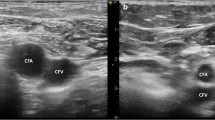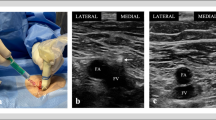Abstract
Background
Ultrasound (US) is being increasingly used to guide vascular access for electrophysiology (EP) procedures in many centres. Nonetheless, the incidence and predictors of vascular complications in the US era are limited. In this study, we describe our experience of vascular access-related complications associated with EP procedures which were performed with the routine use of US-guided vascular access.
Methods
A total of 10,158 consecutive EP procedures in 8361 patients performed from April 2014 (when our centre moved to a policy of routine US-guided vascular access for EP procedures) to March 2022 were included. The outcome of interest was any vascular access-related complication that occurred within 7 days of the procedure; these were classified as severe if surgical intervention and/or blood transfusion was required, major if non-surgical intervention or delayed hospital discharge was required, or minor if it did not fulfil the criteria for severe or major.
Results
During the study period, 2 (0.02%) severe vascular complications occurred, including 1 pseudo-aneurysm requiring surgery and 1 retroperitoneal haemorrhage requiring blood transfusion. Nine (0.09%) major complications occurred, including 6 hematomas managed by compression devices, 1 type B aortic dissection, 1 AV fistula managed conservatively and 1 haematoma managed conservatively but delayed hospital discharge. Eighteen (0.18%) minor haematomas were seen that did not require any intervention or delayed hospital discharge. On multivariable analysis, female sex [OR (95% CI): 2.5 (1.2, 5.4)] and use of an arterial access [OR (95% CI): 19.3 (7.1, 52.3)] were seen to be independent predictors of the 29 vascular complications.
Conclusion
With the use of US-guided vascular access in EP procedures, major vascular complications are exceedingly rare, particularly those needing surgical intervention. Our results provide additional evidence for scientific guidelines to support US use.

Similar content being viewed by others
References
Hussain SK, Eddy MM, Moorman L, Malhotra R, Darby AE, Bilchick K, …, Ferguson JD. Major complications and mortality within 30 days of an electrophysiological procedure at an academic medical center: implications for developing national standards. J Cardiovasc Electrophysiol. 2015;26(5):527–31. https://doi.org/10.1111/jce.12639.
Bohnen M, Stevenson WG, Tedrow UB, Michaud GF, John RM, Epstein LM, …, Koplan BA. Incidence and predictors of major complications from contemporary catheter ablation to treat cardiac arrhythmias. Heart Rhythm. 2011;8(11):1661–6. https://doi.org/10.1016/j.hrthm.2011.05.017.
Deshmukh A, Patel NJ, Pant S, Shah N, Chothani A, Mehta K, …, Viles-Gonzalez JF. In-hospital complications associated with catheter ablation of atrial fibrillation in the United States between 2000 and 2010: analysis of 93 801 procedures. Circulation. 2013;128(19):2104–12. https://doi.org/10.1161/CIRCULATIONAHA.113.003862.
Baum PA, Matsumoto AH, Teitelbaum GP, Zuurbier RA, Barth KH. Anatomic relationship between the common femoral artery and vein: CT evaluation and clinical significance. Radiology. 1989;173(3):775–7. https://doi.org/10.1148/radiology.173.3.2813785.
Prabhu MV, Juneja D, Gopal PB, Sathyanarayanan M, Subhramanyam S, Gandhe S, Nayak KS. Ultrasound-guided femoral dialysis access placement: a single-center randomized trial. Clin J Am Soc Nephrol. 2010;5(2):235–9. https://doi.org/10.2215/CJN.04920709.
Powell JT, Mink JT, Nomura JT, Levine BJ, Jasani N, Nichols WL, …, Sierzenski PR. Ultrasound-guidance can reduce adverse events during femoral central venous cannulation. J Emerg Med. 2014;46(4):519–24. https://doi.org/10.1016/j.jemermed.2013.08.023.
Brass P, Hellmich M, Kolodziej L, Schick G, Smith AF. Ultrasound guidance versus anatomical landmarks for subclavian or femoral vein catheterization. Cochrane Database Syst Rev. 2015;1(1):CD011447. https://doi.org/10.1002/14651858.CD011447.
Wynn GJ, Haq I, Hung J, Bonnett LJ, Lewis G, Webber M, …, Gupta D. Improving safety in catheter ablation for atrial fibrillation: a prospective study of the use of ultrasound to guide vascular access. J Cardiovasc Electrophysiol. 2014;25(7):680–5. https://doi.org/10.1111/jce.12404.
Tanaka-Esposito CC, Tchou P. Ultrasound guided vascular access in the electrophysiology lab: should it be a standard of care? J Interv Cardiac Electrophysiol. Netherlands. 2017. https://doi.org/10.1007/s10840-017-0240-z.
Yamagata K, Wichterle D, Roubícek T, Jarkovský P, Sato Y, Kogure T, …, Kautzner J. Ultrasound-guided versus conventional femoral venipuncture for catheter ablation of atrial fibrillation: a multicentre randomized efficacy and safety trial (ULTRA-FAST trial). Europace. 2018;20(7):1107–14. https://doi.org/10.1093/europace/eux175.
Kupó P, Pap R, Sághy L, Tényi D, Bálint A, Debreceni D, …, Komócsi A. Ultrasound guidance for femoral venous access in electrophysiology procedures-systematic review and meta-analysis. J Interv Card Electrophysiol. 2020;59(2):407–14. https://doi.org/10.1007/s10840-019-00683-z.
Sobolev M, Shiloh AL, Di Biase L, Slovut DP. Ultrasound-guided cannulation of the femoral vein in electrophysiological procedures: a systematic review and meta-analysis. Europace. 2017;19(5):850–5. https://doi.org/10.1093/europace/euw113.
Wang TKM, Wang MTM, Martin A. Meta-analysis of ultrasound-guided vs conventional vascular access for cardiac electrophysiology procedures. J Arrhythmia. 2019;35(6):858–62. https://doi.org/10.1002/joa3.12236.
Triantafyllou K, Karkos CD, Fragakis N, Antoniadis AP, Meletidou M, Vassilikos V. Ultrasound-guided versus anatomic landmark-guided vascular access in cardiac electrophysiology procedures: a systematic review and meta-analysis. Indian Pacing Electrophysiol J. 2022;22(3):145–53. https://doi.org/10.1016/j.ipej.2022.01.005.
Bode K, Ueberham L, Gawlik S, Hindricks G, Bollmann A. Inguinal vascular complications after ablation of atrial fibrillation: an economic impact assessment. Europace. 2019;21(1):91–8. https://doi.org/10.1093/europace/euy132.
Bartoletti S, Mann M, Gupta A, Khan AM, Sahni A, El-Kadri M, …, Gupta D. Same-day discharge in selected patients undergoing atrial fibrillation ablation. Pacing Clin Electrophysiol. 2019;42(11):1448–55. https://doi.org/10.1111/pace.13807.
Chin SH, O’Brien J, Epicoco G, Peddinti P, Gupta A, Modi S, …, Gupta D. The feasibility and effectiveness of a streamlined single-catheter approach for radiofrequency atrial fibrillation ablation. J Arrhythmia. 2020;36(4):685–91. https://doi.org/10.1002/joa3.12390.
Author information
Authors and Affiliations
Corresponding author
Ethics declarations
Ethics approval
The study was approved by the institutional ethics committee.
Informed consent
Written informed consent was obtained from each patient.
Conflict of interest
DG: Speaker for Bayer, BMS/Pfizer, Boehringer Ingelheim, Daiichi-Sankyo, Medtronic, Biosense Webster and Boston Scientific. Proctor for Abbott. Research Grants from Medtronic, Biosense Webster and Boston Scientific. All other authors declare no competing interests.
Additional information
Publisher's note
Springer Nature remains neutral with regard to jurisdictional claims in published maps and institutional affiliations.
Wern Yew Ding and Dibbendhu Khanra are joint first co-authors.
Supplementary Information
Below is the link to the electronic supplementary material.
Rights and permissions
Springer Nature or its licensor holds exclusive rights to this article under a publishing agreement with the author(s) or other rightsholder(s); author self-archiving of the accepted manuscript version of this article is solely governed by the terms of such publishing agreement and applicable law.
About this article
Cite this article
Ding, W.Y., Khanra, D., Kozhuharov, N. et al. Incidence of vascular complications for electrophysiology procedures in the ultrasound era: a single-centre experience over 10,000 procedures in the long term. J Interv Card Electrophysiol 66, 693–700 (2023). https://doi.org/10.1007/s10840-022-01386-8
Received:
Accepted:
Published:
Issue Date:
DOI: https://doi.org/10.1007/s10840-022-01386-8




